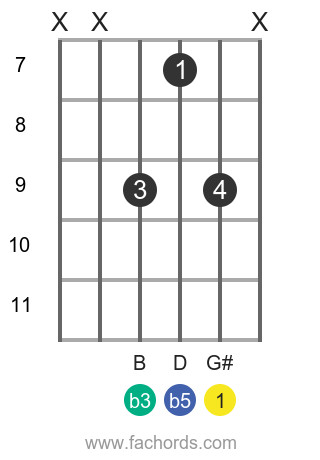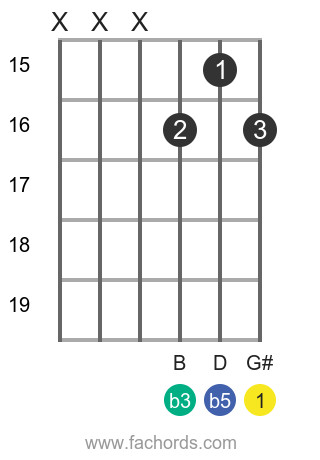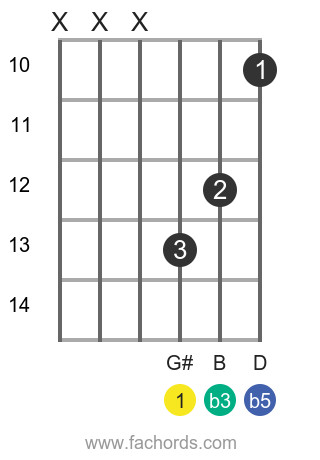The G Diminished Guitar Chord is a fascinating and somewhat mysterious chord that adds a unique flavor to your guitar playing. Often used to create tension and transition in music, understanding the G diminished chord can significantly expand your musical vocabulary. This chord, built from the notes G, Bb, and Db, belongs to the family of diminished chords known for their dissonant yet captivating sound.
To truly grasp the essence of the G diminished chord, it’s essential to understand the intervals that construct it. Diminished chords are formed using the 1st (root), b3rd (minor third), and b5th (diminished fifth) intervals of the major scale. If you’re new to the concept of fretboard intervals and chord construction, delving into resources on fretboard intervals and guitar music theory will be incredibly beneficial. These resources will lay a solid foundation for understanding not just diminished chords, but all chord types on the guitar.
Once you’re comfortable with intervals, the structure of the G diminished chord will become much clearer. You’ll start to recognize how the specific arrangement of these intervals creates the chord’s characteristic sound. Furthermore, exploring chord inversion with the G diminished chord can unlock even more sonic possibilities, revealing different voicings and applications of this versatile chord.
As you progress beyond basic guitar chords, expanding your chord knowledge is crucial. Our intermediate guitar chord tutorial can guide you in discovering a wider range of chords, including more complex and colorful voicings. And for those interested in the theoretical side of things, our guide on chord notation will clarify how chords are named and notated based on their interval composition.
This tutorial aims to provide a comprehensive guide to the G diminished chord. In the following sections, we will explore various chord diagrams, fretboard patterns, and practical tips to help you confidently play and utilize the G diminished chord in your music. Let’s dive in and unlock the secrets of this intriguing chord!
Understanding the Notes of the G Diminished Chord
The G diminished chord is composed of three fundamental notes:
- G – The root note
- Bb – The minor third interval from G
- Db – The diminished fifth interval from G
It’s worth noting that in some contexts, you might see this chord referred to as G# diminished. This is due to enharmonic equivalence, where Db and C# represent the same pitch, and Bb and A# represent the same pitch. Therefore, G# diminished (G#, B, D) is enharmonically equivalent to G diminished (G, Bb, Db). For simplicity and common usage, we will refer to it as the G diminished chord throughout this article.
Building a Diminished Chord: The Formula
Diminished chords follow a specific formula based on intervals. Starting from the root note, you construct a diminished chord using these intervals:
- Root (1)
- Minor Third (b3)
- Diminished Fifth (b5)
This formula applies to all diminished chords, not just G diminished. Understanding this formula allows you to construct any diminished chord by applying these intervals to any root note.
The following table illustrates the intervals used in diminished chord construction:
| Interval | Semitones from Root |
|---|---|
| Root (1) | 0 |
| Minor Second (b2) | 1 |
| Major Second (2) | 2 |
| Minor Third (b3) | 3 |
| Major Third (3) | 4 |
| Perfect Fourth (4) | 5 |
| Diminished Fifth (b5) | 6 |
| Perfect Fifth (5) | 7 |
| Augmented Fifth (#5) | 8 |
| Major Sixth (6) | 9 |
| Minor Seventh (b7) | 10 |
| Major Seventh (7) | 11 |
G Diminished Chord Positions on the Guitar
Below are several positions to play the G diminished chord on the guitar. Chord diagrams are arranged from easier to more challenging fingerings. If you are new to reading chord diagrams, please refer to our guide on how to read chord diagrams. For those struggling with barre chords, our Bar Chords Tips tutorial offers helpful techniques. Alternatively, you can explore a text-based version of these diagrams at our accessible chords page.
Position 1: Movable Shape
This is a movable shape, meaning you can slide it up and down the neck to play other diminished chords. The root note in this position is on the 5th string.
 G diminished chord position 1 guitar chord diagram
G diminished chord position 1 guitar chord diagram
Position 2: Movable Shape
Another movable diminished chord shape, this position has its root note on the 4th string.
 G diminished chord position 2 guitar chord diagram
G diminished chord position 2 guitar chord diagram
Position 3: Movable Shape
This position offers a different voicing for the G diminished chord and is also movable. The root is on the 6th string.
 G diminished chord position 3 guitar chord diagram
G diminished chord position 3 guitar chord diagram
Position 4: Movable Shape
A higher position on the neck, this shape is still movable and provides yet another voicing option. Root is on the 5th string again, but higher up the fretboard.
 G diminished chord position 4 guitar chord diagram
G diminished chord position 4 guitar chord diagram
Position 5: Open Position Shape (Movable)
This shape utilizes open strings and can be moved up the neck as a barre chord variation.
 G diminished chord position 5 guitar chord diagram
G diminished chord position 5 guitar chord diagram
Position 6: Movable Shape
Another movable shape with the root on the 6th string, offering a different finger pattern.
 G diminished chord position 6 guitar chord diagram
G diminished chord position 6 guitar chord diagram
Position 7: Barre Chord Shape (Movable)
This is a barre chord shape, movable and useful for playing diminished chords across the neck. It’s a bit more challenging but very versatile.
 G diminished chord position 7 guitar chord diagram
G diminished chord position 7 guitar chord diagram
Explore our extensive all guitar chords library for even more chord shapes. For a handy reference, you can also download our Free Guitar Chords Chart Pdf for printable chord diagrams.
Playing the G Diminished Chord Across the Fretboard
The fretboard map below visualizes the notes of the G diminished chord across the guitar neck. This map helps you understand the chord’s construction and find different voicings by selecting various combinations of these notes.
[Fretboard map visualization as in original article]
This map is a valuable tool for visualizing chord tones and improvising or creating chord melodies using the G diminished chord.
Using the G Diminished Chord in Music
Diminished chords, including G diminished, are often used to create a sense of tension and instability in music. They are commonly employed as:
- Passing Chords: To smoothly transition between two other chords in a progression. For example, in a C major to F major progression, a G diminished chord can be used as a passing chord: C – Gdim – F.
- Dominant Chord Substitutions: Diminished chords can sometimes substitute for dominant 7th chords, particularly in jazz and blues.
- Creating Harmonic Color: The unique sound of diminished chords adds a distinctive color and sophistication to chord progressions.
Experiment with incorporating the G diminished chord into your own playing and songwriting to discover its versatility and expressive potential.
Tips for Mastering Diminished Chords
- Practice Slowly: Start by practicing each chord shape slowly to ensure clean and accurate finger placement.
- Focus on Finger Placement: Pay close attention to placing your fingers accurately to avoid buzzing or muted notes.
- Movable Shapes are Key: Master the movable shapes to easily play diminished chords in any key.
- Listen Carefully: Listen to how diminished chords sound in different musical contexts to develop your ear and understanding of their function.
- Experiment with Inversions: Explore different inversions of the G diminished chord to find new voicings and sonic textures.
Conclusion
The G diminished guitar chord, while initially sounding complex, is a valuable addition to any guitarist’s chord vocabulary. By understanding its construction, practicing different shapes, and experimenting with its use in musical contexts, you can unlock a new dimension of expression in your playing. Continue to explore other diminished chords and how they can enrich your musical journey. Happy playing!
Explore other diminished chords roots: C dim | D dim | E dim | F dim | G dim | A dim | B dim | C#dim | D#dim | F#dim | G#dim | A#dim | Abdim | Bbdim | Dbdim | Ebdim | Gbdim

